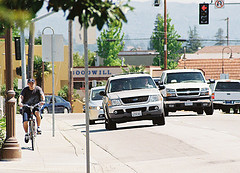Sidewalks: Cruising into the Danger Zone
by Kirby Beck, PCI #002T/EMSCI #017T
Coon Rapids (MN) Police Department (retired)
IPMBA courses have long taught that sidewalks – or pavements for the Brits – are dangerous places to ride a bike; usually more dangerous than the street or road adjacent to them. Every driveway, alley and business entrance is an incident waiting to happen. In many areas, riding on a sidewalk is illegal, even for police and EMS. Business districts can pose the greatest threat of all, and are often the most forbidden of all riding locations.
When a crash or other incident occurs on a sidewalk, it is often hard to defend the public safety cyclist’s actions, especially if sidewalk riding is prohibited in that location. Finding a cycling expert to testify AGAINST you will be much easier than finding someone to help in defending your actions.
Here are several good ways to protect yourself. First, know the law. If riding on sidewalks is prohibited, even for police and EMS, don’t use them. Second, if it is legal, use extra caution. Sidewalks are made for pedestrians. Motorists crossing or approaching sidewalks are searching for people traveling at walking speed. They are not looking for, and do not expect, cyclists moving twice as fast. Next, unless you are patrolling very slowly, stay away from walls, storefronts and businesses. Give yourself extra room to see and to be seen. Every alley, and every driveway, is an intersection and is many times more likely to be the scene of a crash when you are riding on a sidewalk. Slow down and use caution. There is no call, no pursuit and no arrest worth getting yourself into a crash.
There are reasons why public safety cyclists should be allowed to ride on sidewalks. For police, they provide access to some of the favorite haunts of drug dealers, prostitutes and others who provide us with job security. We should be able to use the advantage of the police bike to approach them where they hangout and work. For EMS, they can offer access to persons in need of medical assistance.
If your state or your city prohibits bikes of any kind on sidewalks, work with your union, your police administration and your lawmakers to change it.
Enlist the assistance of your local cycling advocacy organization if they are willing to support you. In 1986, Minnesota passed a law allowing peace officers operating bicycles to disregard certain bicycle laws, if necessary, in the course of their duties. Subdivision 11 of the Minnesota Operation of Bicycles statutes reads: “Peace officer operating bicycle. The provisions of this section governing operation of bicycles do not apply to bicycles operated by peace officers while performing their duties.”
Unlike some laws I have seen, the Minnesota statute does not confuse the issue with whether a police bike is an emergency vehicle or not. It doesn’t care if the bike has a red or blue light or a siren, or whether it was activated. It doesn’t specify whether the officer must be wearing an identifiable uniform. It doesn’t even matter if the officer is a trained cyclist. It does allow sidewalk riding where provided if in the course of the officer’s duties. It permits riding against traffic, or without using a headlight on the roadway. It even allows officers to proceed through stop signs and red lights. Notice too that nothing in the statute relieves the officer of liability if they fail to use due caution and regard for others. Just because it may be permitted, running a traffic control on a bicycle is often foolish. Speeding down a sidewalk and crashing into a pedestrian or a motorist is obviously NOT okay.
In the movie Top Gun, Tom Cruise and his Tomcat fighter had their “danger zone”; as public safety cyclists, we also have ours. One of the greatest danger zones is the sidewalk. As children many us of were taught that sidewalks are the safest place to ride a bike. As adults our wisdom and experience should teach us that not everything we learned as children was correct. That, my friends, is one of them. Be extra cautious when cycling in the “danger zone.”
Kirby is an Instructor Trainer and one of the original authors of the Complete Guide to Police Cycling and the IPMBA course curricula. He contributed to the Complete Guide to Public Safety Cycling, 2nd Edition, and the forthcoming Instructor ToolKit CD-ROM. He currently offers consulting and expert witness services in cycling matters.
© 2008 IPMBA. This article appeared in the Fall 2008 issue of IPMBA News.

